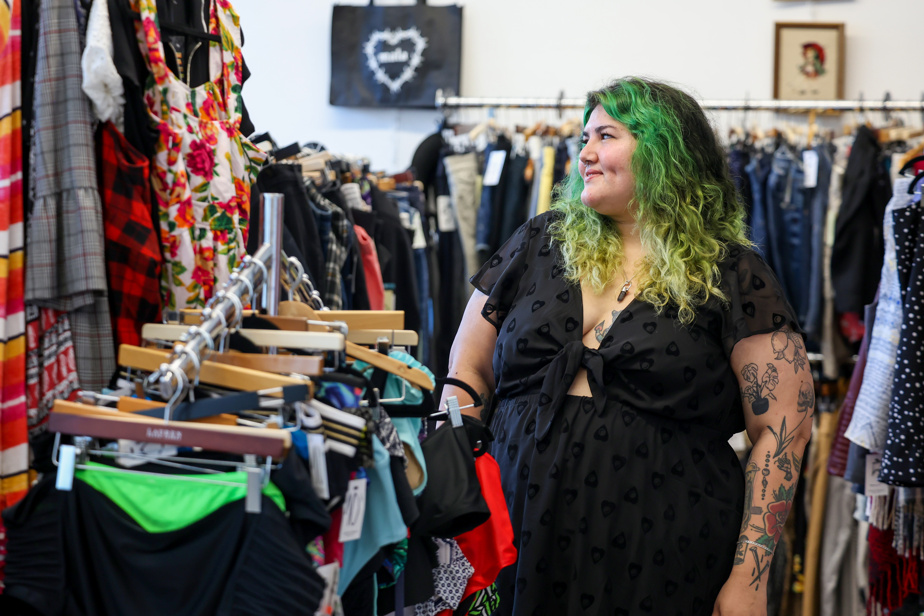Discouraged by the lack of supply in large thrift stores, Sandra Munoz Diaz opened, in December 2022, Mala, a thrift store for large-size clothes. She wants to give a safe space for people who can’t get dressed in second-hand clothing stores.
“There are a lot of people who are moved when they shop here… It’s the first time they can try on several pieces of linen that they like,” says the owner in an interview with The Press.
The choice is often limited in traditional stores for those who wear large sizes, and the vice closes when it comes to second-hand clothes. Whether out of financial concern or environmental awareness, dressing in a thrift store becomes an even more difficult task.
According to a study by Statista published last September, sales of plus-size women’s clothing (14 years and over) generated approximately $1.73 billion in Canada in 2020, compared to $520 million for so-called petite sizes. One fact remains: it is difficult for them to find clothes that reflect them. Research is time-consuming, which often contributes to the popularity of online shopping and, most of the time, on shopping sites. fast fashion. The ecological footprint of this massive production industry is among the largest in the world.

PHOTO FRANÇOIS ROY, THE PRESS
Mala offers clothing sizes ranging from XL to 5XL.
“I understand that plus-size people are turning to stores that make fast fashion. If they live far from urban neighborhoods or if they have children, they don’t always have time to shop around for second-hand clothes, several times a week, to find one or two pieces,” explains Sandra Munoz Diaz.
For Mala’s owner, accessibility to clothing is central to her company’s values. “Although I sell retro clothes and unique pieces, I try to keep my prices as low as possible. Some of my tracks are $10 or $15. My goal is that people can find several clothes without having to stress financially. »
to feel bullied
Myriam Daigneault-Roy is a loyal customer at Mala. About 80% of her wardrobe comes from the inclusive thrift store. According to her, the lack of accessibility in big-box stores contributes to the stigmatization of fat people and, consequently, aggravates the lack of esteem of many of them.
We associate a lot of self-esteem with the role models presented to us. It’s demoralizing not to have access to any clothing that represents you. I have the impression that fashion often makes us realize that our body is not adequate. In these cases, it is difficult to be your own model.
Myriam Daigneault-Roy, loyal customer at Mala
Singer and influencer Vanessa Duchel agrees. “It’s important to be able to express yourself through your clothes. I was bullied for a long time and felt that my linen did not reflect my personality and my style, because I couldn’t find pieces in my size that represented me. »

PHOTO PROVIDED BY SONIA GAGNON AGENCY
Vanessa Duchel says she has difficulty finding clothes that represent her personality.
The artist, who has nearly 35,000 subscribers on the Instagram social network, tries to serve as a role model for people for whom dressing up rhymes with stress. “We agree that, whether we are thin or not, we all need clothes in which we feel good. It is a fundamental right to be able to dress! “, she says.
Myriam Daigneault-Roy deplores the fact that many women have no choice but to turn to fast fashion where they have to buy without trying on the clothes. Shopping online can be another self-esteem failure if the pieces are too small or don’t fit well. “It’s not supposed to be a luxury to be able to try on your clothes before you buy them. »
The fashion oversized
The trend oversized and the popularity of oversized clothing purchased from thrift stores has also gained ground, leaving plus-size people with little choice.
The three young women agree: thin people don’t purposely take clothes that might interest plus-size people. “Nobody is malicious by buying bigger clothes. But you have to be aware of the impact it has on others who have less choice,” explains Myriam.
“There are people who only have $10 to buy a t-shirt… You have to think about that when you purposely buy clothes that are three sizes larger. Some people have no choice but to buy their clothes from thrift stores. What do they do when regular sized people take the biggest clothes and cut them into sweaters crop top? asks Sandra Munoz Diaz.

PHOTO FRANÇOIS ROY, THE PRESS
Sandra Munoz Diaz wants her thrift store to be a reassuring place for her customers.
Vanessa Duchel believes that this fight belongs to everyone. “I urge people of all sizes to ask companies for more size diversity, both in thrift stores and in regular stores. »
The influencer does not hesitate to use her platform to talk about the subject. “I’ve been trying to make my followers aware for several years that if you don’t wear 2X or 3X, leave it to those who can’t afford new clothes or can’t find them elsewhere. »
Sandra Munoz Diaz adds that she would not discriminate by banning thinner people from getting clothes in her store. On the other hand, she emphasizes that the people who find themselves at Mala are well aware of the problem, and “once they are aware, it becomes natural to think about this kind of issue”.
